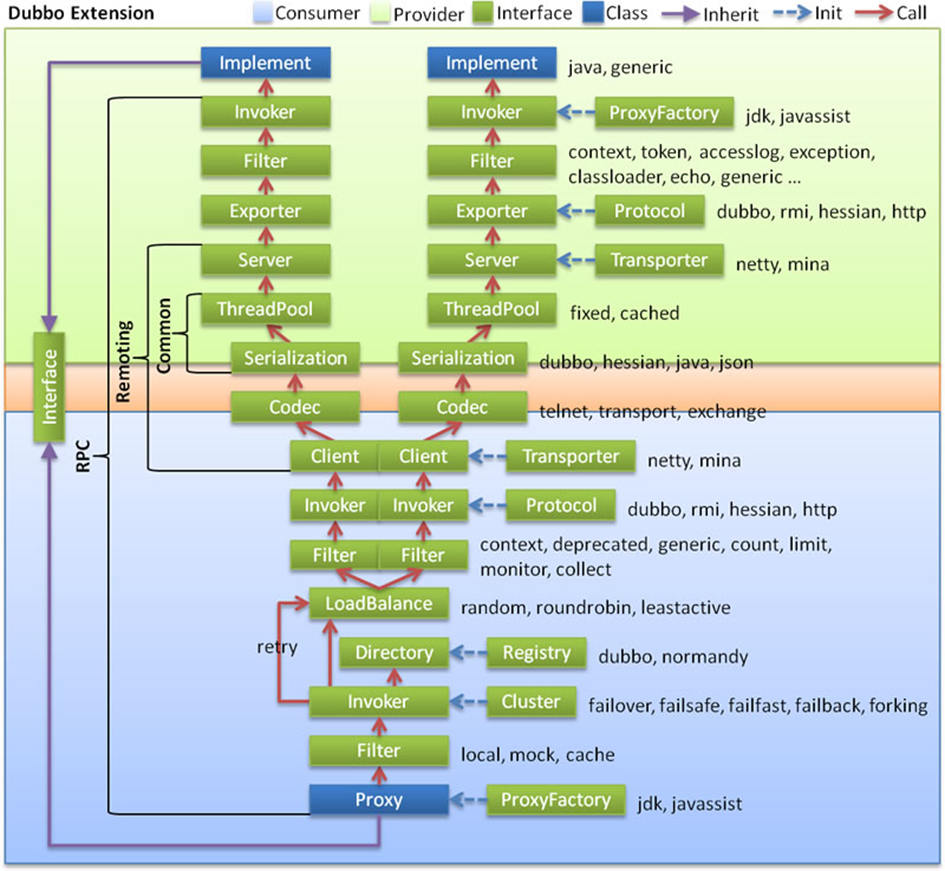一、服务调用流程
1、服务引用完成之后,会返回一个代理对象。

2、通过 debug,会来到 InvokerInvocationHandler 的 invoker 方法
@Override
public Object invoke(Object proxy, Method method, Object[] args) throws Throwable {
String methodName = method.getName();
Class<?>[] parameterTypes = method.getParameterTypes();
if (method.getDeclaringClass() == Object.class) {
return method.invoke(invoker, args);
}
if ("toString".equals(methodName) && parameterTypes.length == 0) {
return invoker.toString();
}
if ("hashCode".equals(methodName) && parameterTypes.length == 0) {
return invoker.hashCode();
}
if ("equals".equals(methodName) && parameterTypes.length == 1) {
return invoker.equals(args[0]);
}
return invoker.invoke(new RpcInvocation(method, args)).recreate();
}
3、执行 invoke 方法,来到 MockClusterInvoker 类的 invoke 方法,
@Override
public Result invoke(Invocation invocation) throws RpcException {
Result result = null;
String value = directory.getUrl().getMethodParameter(invocation.getMethodName(), Constants.MOCK_KEY, Boolean.FALSE.toString()).trim();
if (value.length() == 0 || value.equalsIgnoreCase("false")) {
//no mock
result = this.invoker.invoke(invocation);
} else if (value.startsWith("force")) {
if (logger.isWarnEnabled()) {
logger.info("force-mock: " + invocation.getMethodName() + " force-mock enabled , url : " + directory.getUrl());
}
//force:direct mock
result = doMockInvoke(invocation, null);
} else {
//fail-mock
try {
result = this.invoker.invoke(invocation);
} catch (RpcException e) {
if (e.isBiz()) {
throw e;
} else {
if (logger.isWarnEnabled()) {
logger.warn("fail-mock: " + invocation.getMethodName() + " fail-mock enabled , url : " + directory.getUrl(), e);
}
result = doMockInvoke(invocation, e);
}
}
}
return result;
}
4、再执行会到 AbstractClusterInvoker 类的Invoker
@Override
public Result invoke(final Invocation invocation) throws RpcException {
checkWhetherDestroyed();
LoadBalance loadbalance = null;
//去注册中心获取方法的执行者 invoker
List<Invoker<T>> invokers = list(invocation);
if (invokers != null && !invokers.isEmpty()) {
//获取负载均衡策略
loadbalance = ExtensionLoader.getExtensionLoader(LoadBalance.class).getExtension(invokers.get(0).getUrl()
.getMethodParameter(invocation.getMethodName(), Constants.LOADBALANCE_KEY, Constants.DEFAULT_LOADBALANCE));
}
RpcUtils.attachInvocationIdIfAsync(getUrl(), invocation);
return doInvoke(invocation, invokers, loadbalance);
}
5、doInvoke 会来到 FailoverClusterInvoker 类的 doInvoke 方法
@Override
@SuppressWarnings({"unchecked", "rawtypes"})
public Result doInvoke(Invocation invocation, final List<Invoker<T>> invokers, LoadBalance loadbalance) throws RpcException {
List<Invoker<T>> copyinvokers = invokers;
checkInvokers(copyinvokers, invocation);
int len = getUrl().getMethodParameter(invocation.getMethodName(), Constants.RETRIES_KEY, Constants.DEFAULT_RETRIES) + 1;
if (len <= 0) {
len = 1;
}
// retry loop.
RpcException le = null; // last exception.
List<Invoker<T>> invoked = new ArrayList<Invoker<T>>(copyinvokers.size()); // invoked invokers.
Set<String> providers = new HashSet<String>(len);
for (int i = 0; i < len; i++) {
//Reselect before retry to avoid a change of candidate `invokers`.
//NOTE: if `invokers` changed, then `invoked` also lose accuracy.
if (i > 0) {
checkWhetherDestroyed();
copyinvokers = list(invocation);
// check again
checkInvokers(copyinvokers, invocation);
}
//根据负载均衡策略,选择一个 invoker
Invoker<T> invoker = select(loadbalance, invocation, copyinvokers, invoked);
invoked.add(invoker);
RpcContext.getContext().setInvokers((List) invoked);
try {
// invoker 里面包含了各种的 filter 和 invoker信息,最终会执行 DubboInvoker
Result result = invoker.invoke(invocation);
if (le != null && logger.isWarnEnabled()) {
logger.warn("Although retry the method " + invocation.getMethodName()
+ " in the service " + getInterface().getName()
+ " was successful by the provider " + invoker.getUrl().getAddress()
+ ", but there have been failed providers " + providers
+ " (" + providers.size() + "/" + copyinvokers.size()
+ ") from the registry " + directory.getUrl().getAddress()
+ " on the consumer " + NetUtils.getLocalHost()
+ " using the dubbo version " + Version.getVersion() + ". Last error is: "
+ le.getMessage(), le);
}
return result;
} catch (RpcException e) {
if (e.isBiz()) { // biz exception.
throw e;
}
le = e;
} catch (Throwable e) {
le = new RpcException(e.getMessage(), e);
} finally {
providers.add(invoker.getUrl().getAddress());
}
}
throw new RpcException(le != null ? le.getCode() : 0, "Failed to invoke the method "
+ invocation.getMethodName() + " in the service " + getInterface().getName()
+ ". Tried " + len + " times of the providers " + providers
+ " (" + providers.size() + "/" + copyinvokers.size()
+ ") from the registry " + directory.getUrl().getAddress()
+ " on the consumer " + NetUtils.getLocalHost() + " using the dubbo version "
+ Version.getVersion() + ". Last error is: "
+ (le != null ? le.getMessage() : ""), le != null && le.getCause() != null ? le.getCause() : le);
}
6、DubboInvoker 真正的执行调用
@Override
protected Result doInvoke(final Invocation invocation) throws Throwable {
RpcInvocation inv = (RpcInvocation) invocation;
final String methodName = RpcUtils.getMethodName(invocation);
inv.setAttachment(Constants.PATH_KEY, getUrl().getPath());
inv.setAttachment(Constants.VERSION_KEY, version);
//客户端
ExchangeClient currentClient;
if (clients.length == 1) {
currentClient = clients[0];
} else {
currentClient = clients[index.getAndIncrement() % clients.length];
}
try {
boolean isAsync = RpcUtils.isAsync(getUrl(), invocation);
boolean isOneway = RpcUtils.isOneway(getUrl(), invocation);
int timeout = getUrl().getMethodParameter(methodName, Constants.TIMEOUT_KEY, Constants.DEFAULT_TIMEOUT);
if (isOneway) {
boolean isSent = getUrl().getMethodParameter(methodName, Constants.SENT_KEY, false);
currentClient.send(inv, isSent);
RpcContext.getContext().setFuture(null);
return new RpcResult();
} else if (isAsync) {
ResponseFuture future = currentClient.request(inv, timeout);
RpcContext.getContext().setFuture(new FutureAdapter<Object>(future));
return new RpcResult();
} else {
RpcContext.getContext().setFuture(null);
//客户端发起请求,获取响应
return (Result) currentClient.request(inv, timeout).get();
}
} catch (TimeoutException e) {
throw new RpcException(RpcException.TIMEOUT_EXCEPTION, "Invoke remote method timeout. method: " + invocation.getMethodName() + ", provider: " + getUrl() + ", cause: " + e.getMessage(), e);
} catch (RemotingException e) {
throw new RpcException(RpcException.NETWORK_EXCEPTION, "Failed to invoke remote method: " + invocation.getMethodName() + ", provider: " + getUrl() + ", cause: " + e.getMessage(), e);
}
}
7、request 发送请求
ReferenceCountExchangeClient:
@Override
public ResponseFuture request(Object request, int timeout) throws RemotingException {
return client.request(request, timeout);
}
HeaderExchangeClient:
@Override
public ResponseFuture request(Object request, int timeout) throws RemotingException {
return channel.request(request, timeout);
}
HeaderExchangeChannel:
@Override
public ResponseFuture request(Object request, int timeout) throws RemotingException {
if (closed) {
throw new RemotingException(this.getLocalAddress(), null, "Failed to send request " + request + ", cause: The channel " + this + " is closed!");
}
// create request.
Request req = new Request();
req.setVersion("2.0.0");
req.setTwoWay(true);
req.setData(request);
DefaultFuture future = new DefaultFuture(channel, req, timeout);
try {
channel.send(req);
} catch (RemotingException e) {
future.cancel();
throw e;
}
return future;
}
发送请求完毕后,还会设置超时时间,如果超时了,还会进行重试机制,获取响应后,还会进行解码等工作,直到获取响应结果。
总体来说,就是通过层层的包装,使用 Netty 来进行网络通信的。
二、服务引用流程图
